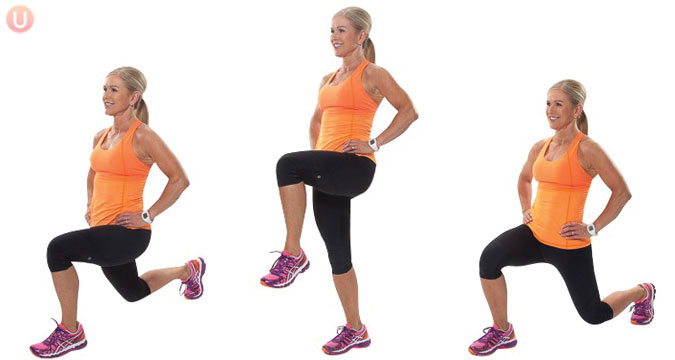This post contains affiliate links. Please see our disclosure policy.

Pass Through Lunges is a lower body exercise that strengthens your legs and glutes while providing a great cardio benefit along the way. If you learn how to do Pass Through Lunges you will have both a muscle and a cardiovascular move all in one. This is a multi-tasking effort that you can use to save time in your workouts.
By now you are likely familiar with a variety of ways to perform lunges. Stationary lunges, forward lunges and reverse lunges are the most common. However, the Pass Through Lunge is a unique way to get all the benefits of other lunges while adding a benefit of balance challenge and a cardiovascular boost.
Why? Because as your leg passes back and forth between the front and back, your heart rate will rise providing you with a cardio boost and you are temporarily standing on one foot while moving the other leg.
This is an awesome balance challenge. Balance is an element of fitness that is all-to-often forgotten. It is important to learn; especially as you age.
Lunges are the best overall exercise for strengthening your legs and glutes. Sometimes knee problem can get in the way of practicing lunges. If that is the case, default to the reverse lunge or skip lunges and focus on squats instead. However, lunges are a sure fire way to activate your glutes and get a better butt if you do them properly. It is important to practice proper form during the Pass Through Lunge.
Make sure to keep your knee at a 90 degree angle and be careful that it doesn’t extend over your toes.
That is generally the cause of the majority of knee pain.
Practice Pass Through Lunges a few times a week. You can do them with weights in your hands or with no weight at all.
Pass Through Lunge Instructions
- Stand with feet hip distance apart. Step right foot behind and lower slowly to a lunge for until both legs are at a 90-degree angle.
- Then lift right leg up and let it float slowly to the front lowering again to 90-degrees.
- Now push right foot up again and float it behind you as you did the first time. After 8-10 reps, switch legs.
Targets: glutes, quads, hamstrings


